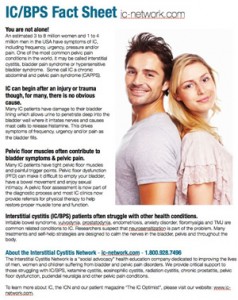CEU/CME Opportunities for IC/BPS
International Standards
CUA Guidelines (Canada)
In Spring 2016, the Canada Urology Association released new guidelines for the diagnosis and treatment of ICBPS that are very similar to the AUA Guidelines below but with some important distinctions. What makes the CUA Guidelines the most revolutionary of all the national guidelines is their strong recommendation that patients be first assessed to determine what pelvic pain phenotype they may fit within by using the UPOINT system. This way, the most promising and appropriate therapy can be directed for that unique patient situation. Unfortunately, they provide no guidelines for the treatment of bladder and pelvic pain. Read more here!
AUA Guidelines (USA)
 In 2011 (rev.2014), the American Urology Association released their first consensus based guidelines for the diagnosis and treatment of interstitial cystitis / bladder pain syndrome. This revolutionary document provides clear parameters for diagnosis. Hydrodistention with cystoscopy is no longer considered gold standard and is now only recommended if the diagnosis in doubt. The AUA also discourages the use of high pressure, long duration distentions in favor of the less risky, low pressure, short duration procedure.
In 2011 (rev.2014), the American Urology Association released their first consensus based guidelines for the diagnosis and treatment of interstitial cystitis / bladder pain syndrome. This revolutionary document provides clear parameters for diagnosis. Hydrodistention with cystoscopy is no longer considered gold standard and is now only recommended if the diagnosis in doubt. The AUA also discourages the use of high pressure, long duration distentions in favor of the less risky, low pressure, short duration procedure.
The new treatment protocol follows a six step treatment protocol that provides a clear, simple treatment plan that minimizes the risk of adverse events, affordability and supports the use of self-help strategies, such as diet modification.
- Read the ICN Summary (2 pages)
- ICN Treatment Checklist and Summary (3 pages)
- Read the full AUA Guidelines (67 pages)
- Watch the AUA Guidelines Video
ESSIC Guidelines – Bladder Pain Syndrome (BPS/IC) – Europe
The European Society for the Study of BPS (aka ESSIC) uses Bladder Pain Syndrome for the majority of patients struggling with symptoms. Interstitial Cystitis is reserved for patients with Hunner’s Lesions. Another key difference is the use and role of hydrodistention. The European community requires an examination of the bladder wall via hydrodistention to confirm any diagnosis on BPS or IC. The USA, on the other hand, only uses hydrodistention in cases when the diagnosis may be in doubt. Learn more
Asian Guidelines – Hypersensitive Bladder Syndrome
The Society of Interstitial Cystitis Japan has made a remarkable contribution with the publication of their guidelines for the diagnosis and treatment of IC. Its discussion of the epidemiology, diagnosis and treatment of IC is impressive, citing 220 supporting references. For clinicans who want to make decisions based upon evidence based medicine, this is THE document to begin with though the citations do stop with the year 2005. Beautifully written, concise summaries and easy to read. Read the full text now!
CME, CNE & CEU Opportunities
CEU’s & CME’s are online educational articles that physicians, nurses and other health care providers can take to earn continuing education credits. They can also be used to educate family, friends and, of course, other medical professionals about interstitial cystitis. We’ve developed a list of articles that we feel are superb.
- Society of Urologic Nurses Interstitial Cystitis CNE – October 10, 2010 – Jill Leanne Freeman MAN, APRM-BC, ANP, CUNP – Watch it now!
- Diagnostic options for early identification and management of interstitial cystitis/painful bladder syndrome.Forrest JB, Moldwin R. – Int J Clin Pract. 2008 Dec;62(12):1926-34. – This comprehensive article reviews the pros and cons of various diagnostic methodologies including hydrodistention, cystoscopy, bladder biopsy, KCL Testing, intravesical anesthetic challenge and more! Designed to help general practitioners make an early yet accurate diagnosis. (December 2008) Read full text here!
- Interstitial Cystitis – Rovner E, Lebed B – Medscape – This general article was written for Medscape by Eric Rovner, MD, Co-Director of Female Urology, Neurourology and Urodynamics, Assistant Professor, Department of Surgery, Division of Urology, University of Pennsylvania. It thoroughly covers diagnosis and treatments. (December 2008) – Read the full text here!
- Medscape – Diagnosis and Management of of Interstitial Cystitis
- Association of Reproductive Health Professionals – Screening, Treatment and Management of IC/PBS
- Association of Reproductive Health Professionals – Diagnosis and Management of IC/PBS
Older or Outdated Publications
- Interstitial Cystitis/Painful Bladder Syndrome: An Update For Clinicians
- Is It Really Another UTI: Interstitial Cystitis and the Pharmacist’s Role in Identifying the Patient At Risk .
- Diagnostic Evaluation of Chronic Pelvic Pain of Bladder Origin
- The Clinical Management of Interstitial Cystitis
- Interstitial Cystitis
Revised – January 21, 2017
Author – Jill H. Osborne
